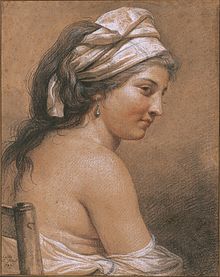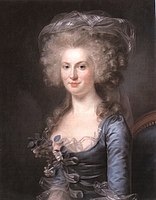| Marie-Gabrielle Capet | |
|---|---|
 Self portrait in 1783, in the collection of the National Museum of Western Art in Tokyo Self portrait in 1783, in the collection of the National Museum of Western Art in Tokyo | |
| Born | (1761-09-06)6 September 1761 Lyon, France |
| Died | 1 November 1818(1818-11-01) (aged 57) Paris, France |
| Style | Neoclassicism |
Marie-Gabrielle Capet (6 September 1761 – 1 November 1818) was a French Neoclassical painter. She was born in Lyon on 6 September 1761. Capet came from a modest background and her previous background and artistic training is unknown, but in 1781 she became the pupil of the French painter Adélaïde Labille-Guiard in Paris. She excelled as a portrait painter and her works include oil paintings, watercolours, and miniatures.
Life


Marie-Gabrielle Capet was born in Lyon in 1761. In her youth, Capet attended a public drawing school located in her town. In eighteenth-century France, the Royal Academy of Art was responsible for training artists and exhibiting artworks at the Salon that glorified heroic values promoted by the Bourbon monarchy. Until the French Revolution, the Royal Academy of Art in Paris was the central institution for official artistic practice, and limited its number of female students to four at a time. In 1781, twenty-year-old Capet moved to Paris to become the student of Adélaïde Labille-Guiard (1749–1803), a Neoclassical artist who was admitted to the Academy in 1783.
Capet showed her early work at the Exposition de la jeunesse in 1781 and 1783, and later exhibited at the Salon when it was opened to all artists after the French Revolution. Her body of work included miniature paintings, oil paintings, and pastels, which were praised for their virtuoso draftsmanship and use of colour. Many of her pastel paintings were portraits, though by 1808 she was regarded as a history painter in her own right. She counted among other customers several members of the royal family, and other members of Paris society, such as the lawyer Pierre-Nicolas Berryer and the playwright Joseph Chénier.
Capet and Labille-Guiard not only enjoyed a professional relationship, but were also close family friends. Capet would move in with her teacher at the Louvre until Labille-Guiard's death. Even after Labille-Guiard married the painter François Vincent in 1799, Capet continued to live in their home. After Labille-Guiard's death, Capet lived with her husband until his death in 1816. Upon his death, Capet purchased Labille-Guiard and Vincent's estate.
Among her works the best known are those of Mesdames Adelaide and Victoire, Madame Vincent surrounded by her pupils, Mlle. Mars, and Jean-Antoine Houdon. At that time, the Academy had limited the members of women painters to only four female members. She died in Paris in 1818.
Works
The work of Marie-Gabrielle Capet contains a large collection of miniature portraits, the majority of which are housed in The Louvre. Included in this collection are portraits of Madame Martin de Lesseps, Madame Elisabeth, sister of Louis XVI, and Mademoiselle Mars.

Though little work of Capet is known, there have been some miniatures attributed to her that are speculated to be of Elisabeth-Philippine-Marie-Helene de France, often called Madame Elisabeth. Madame Elisabeth was famously painted by Labille-Guiard as well. The unsigned miniature that is presumed to be of Madame Elisabeth is located at Musée du Louvre. The miniature depicts a woman in a white, muslin dress and a dark sash. Other miniatures signed by Capet have unknown whereabouts.
-
 Princess Marie Adélaïde of France
Princess Marie Adélaïde of France
-
 The atelier of Madame Vincent, painting from 1808 now in the Neue Pinakothek, Munich.
The atelier of Madame Vincent, painting from 1808 now in the Neue Pinakothek, Munich.
-
 Gabrielle Marie Capet: Simon Charles Miger, 1806
Gabrielle Marie Capet: Simon Charles Miger, 1806
See also
References
- "Marie-Gabrielle Capet". collection.nmwa.go.jp.
- For a complete monograph on Capet's life, see Arnauld Doria, Gabrielle Capet, Paris: Les Beaux-Arts, 1934.
- ^ Perez, Alexandra Michele. "Under the Shadow of Her Teacher: Marie-Gabrielle Capet in the Studio of Adélaïde Labille-Guiard" (PDF). Retrieved 15 November 2020.
- Laura Auricchio, "Self-Promotion in Adélaïde Labille-Guiard's 1785 "Self Portrait with Two Students", The Art Bulletin, Vol. 89, No. 1 (March 2007)
- "Brooklyn Museum: Adélaïde Labille-Guiard". www.brooklynmuseum.org. Retrieved 7 September 2021.
- Delia Gaze, "Capet, Gabrielle", Dictionary of Women Artists (1997: Fitzroy Dearborn Publishers)
- Charles Landon "Salon de 1808", Journal des Arts, des Sciences, et de Littérature, no. 170. 10 Frimaire an 10, p. 65.
- (in French)"Marie-Gabrielle Capet". /www.femmespeintres.net. Archived from the original on 27 April 2016.
- ^ Heller, Nancy G., Women Artists: An Illustrated History, Abbeville Press, Publishers, New York 1987 ISBN 978-0-89659-748-8
- Uglow, Jennifer S.; Hendry, Maggy (1999). marie-gabrielle+capet+biography. ISBN 9781555534219. Retrieved 21 March 2017.
- "marie-gabrielle+capet+biography". Retrieved 21 March 2017.
- "Women Artists in Nineteenth–Century France". /www.metmuseum.org.
- DE JESÚS, MARY SPRINSON (2008). "Adélaïde Labille-Guiard's Pastel Studies of the Mesdames de France". Metropolitan Museum Journal. 43: 157–172. doi:10.1086/met.43.25699092. ISSN 0077-8958. JSTOR 25699092. S2CID 191391110.
- Golemba, Beverly E. (1992). Lesser-known Women: A Biographical Dictionary. Boulder u.a.: Rienner. p. 37. ISBN 978-1-55587-301-1.
- "Self–Portrait with Two Pupils". www.metmuseum.org. Retrieved 21 March 2017.
- Zoffany, Johan (1771–1772). "The Royal Academicians". The Royal Collection. Retrieved 21 March 2017.
- "Articles/Capet" (PDF). www.pastellists.com. Retrieved 11 February 2015.
- "Jaconde, Portal of the Collections of the Museums of France". Culture.couv.fr. Retrieved 13 April 2017.
- ^ DE JESÚS, MARY SPRINSON (2008). "Adélaïde Labille-Guiard's Pastel Studies of the Mesdames de France". Metropolitan Museum Journal. 43: 157–172. doi:10.1086/met.43.25699092. ISSN 0077-8958. JSTOR 25699092. S2CID 191391110.
Attribution:
 This article incorporates text from a publication now in the public domain: Bryan, Michael (1886). "Capet, Marie Gabrielle". In Graves, Robert Edmund (ed.). Bryan's Dictionary of Painters and Engravers (A–K). Vol. I (3rd ed.). London: George Bell & Sons. p. 228.
This article incorporates text from a publication now in the public domain: Bryan, Michael (1886). "Capet, Marie Gabrielle". In Graves, Robert Edmund (ed.). Bryan's Dictionary of Painters and Engravers (A–K). Vol. I (3rd ed.). London: George Bell & Sons. p. 228.